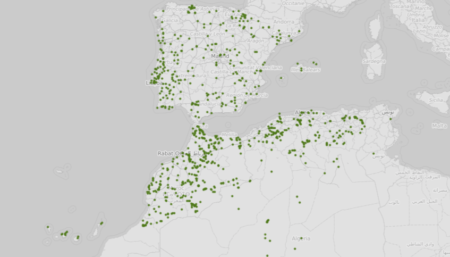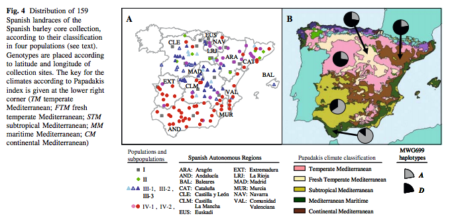- AdaptMap: exploring goat diversity and adaptation. Strong geographic structuring.
- Insights into the genetic diversity of indigenous goats and their conservation priorities. “…if one breed could survive in changing conditions all the time, the straightforward approach is to increase its utilization and attraction for production via mining breed germplasm characteristic.” If…
- Leveraging agriculture for nutrition in South Asia: What do we know, and what have we learned? To do its part for nutrition, agriculture needs to play nice with other sectors. Here comes the evidence base.
- A global synthesis reveals biodiversity-mediated benefits for crop production. Service-providing organisms really do provide services.
- Intensifying Inequality? Gendered Trends in Commercializing and Diversifying Smallholder Farming Systems in East Africa. Commercialization good for men, diversification good for women. Maybe do both? And more on commercialization.
- Iron biofortification interventions to improve iron status and functional outcomes. Cognitive performance improved, but no effect on iron deficiency or anaemia. So complicated.
- In vitro tissue culture of apple and other Malus species: recent advances and applications. Lots of tinkering still needed.
- Mediterranean and Northern Iberian gene pools of wild Castanea sativa Mill. are two differentiated ecotypes originated under natural divergent selection. One xeric, the other mesophytic. Satisfyingly uncomplicated.
- Guidelines for seed collection of Araucaria angustifolia (Bertol.) Kuntze: A genetic, demographic and geographic approach. Watch out for fragmentation.
- Screening of wild potato genetic resources for combined resistance to late blight on tubers and pale potato cyst nematodes. 5% of about 1000 very resistant. Another 1000 to go.
- Connecting genebanks to farmers in East Africa through the distribution of vegetable seed kits. Distributing 42,000 seed kits with 183,000 vegetable seed samples in 5 years generates lots of questions.
- Role and management of soil biodiversity for food security and nutrition; where do we stand? We stand uncertain is where we stand.
- Genetic Approaches to Improve Common Bean Nutritional Quality: Current Knowledge and Future Perspectives. Not as nutritious as it could be.
- Trophic Cascade in Seaweed Beds in Sanriku Coast Hit by the Huge Tsunami on 11 March 2011: Sea Urchin Fishery as a Satoumi Activity Serving for Increase in Marine Productivity and Biodiversity. Human-intervention-encourages-biodiversity shock. In other news, Japan has a sea urchin fishery.
- Molecular evidence for repeated recruitment of wild Christmas poinsettia (Euphorbia pulcherrima) into traditional horticulture in Mexico. Fancy genotyping shows plants in gardens were transplanted from the wild. Why not just ask the gardeners though?
The crop wild relatives of North America are done
Congratulations to Colin and all the authors and editors.
https://twitter.com/ColinKhoury/status/1106278018618716162
The wheat in Spain grows all over
The researchers were also able to group Spaniards into five genetic clusters. On a map, these groups form five strips running north to south. Those strips line up neatly with history.
I wonder if you’d get a similar pattern looking at crops, say wheat. There’s lots of material in genebanks to play around with.
LATER: Thanks to David Marshall for pointing out that work has been done on barley.
It just needs someone to compare the patterns now. And repeat for other crops.
Breeding Africa’s next super-vegetables
Ready to take your company to the next level? Join the Africa Vegetable Breeding Consortium and discover how exposure to the latest research and closer contact with international breeders and scientists will change the way you do breeding and business.
The main benefit?
Consortium companies will be able to view a broad array of PYT [preliminary yield trials] entries in the field at least 12 months before the material is made public. Participants may have early access to screening protocols or other kinds of scientific information developed at WorldVeg, provided the sharing of such information does not conflict with existing WorldVeg agreements or policies.
Remember that WorldVeg sits on a huge reservoir of diversity, and has talented plant breeders that make the most of it.
LATER: Looking forward to seeing an African vegetable among these.
LATER STILL: Maybe we need a SeedTracker for vegetables?
Brainfood: Forage seeds, Meat is murder, Medieval farming, Bean breeding, Moth bean genomics, Red List definitions, Amaranth domestication, Seed networks, Local adaptation, Social norms, Food demand, Grasspea future, Strawberry evolution, Maracuoccio
- Medium-term seed storage of diverse genera of forage grasses, evidence-based genebank monitoring intervals, and regeneration standards. One size does not fit all.
- Sustainability gridlock in a global agricultural commodity chain: Reframing the soy–meat food system. Divide and conquer.
- Farm establishment, abandonment and agricultural practices during the last 1,300 years: a case study from southern Sweden based on pollen records and the LOVE model. Medieval Swedes got high.
- A review of breeding objectives, genomic resources, and marker-assisted methods in common bean (Phaseolus vulgaris L.). Oh dear, a worldwide catalogue of germplasm needed.
- Construction of genetic linkage map and genome dissection of domestication-related traits of moth bean (Vigna aconitifolia), a legume crop of arid areas. No word on whether a catalogue is needed.
- Resources and opportunities for re-establishing Lathyrus cicera L. as a multipurpose cultivated plant. I’d try it. But do a catalogue first.
- Ex situ seed banks and the IUCN Red List. When is extinct not extinct?
- Convergent seed color adaptation during repeated domestication of an ancient new world grain. Grain amaranth selected 3 times independently from same wild precursor, but always for the same colour.
- Modeling epidemics in seed systems and landscapes to guide management strategies: The case of sweetpotato in Northern Uganda. Spread of disease depends on where it starts. Watch out for places with lots of out-nodes.
- A Molecular View of Plant Local Adaptation: Incorporating Stress-Response Networks. Adaptation here does not necessarily mean no adaptation there. Interesting for breeders?
- Using social norms to encourage healthier eating. To get kids to eat broccoli, tell them their favourite youtuber does. Probably generalizable.
- Nutrition Transition and the Structure of Global Food Demand. Lower growth in overall food demand than in the past, but a doubling of demand for animal calories.
- Grass pea (Lathyrus sativus L.): orphan crop, nutraceutical or just plain food? Needs to shed its bad image.
- Origin and evolution of the octoploid strawberry genome. All four parents tracked down.

